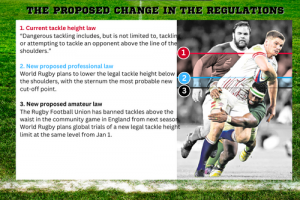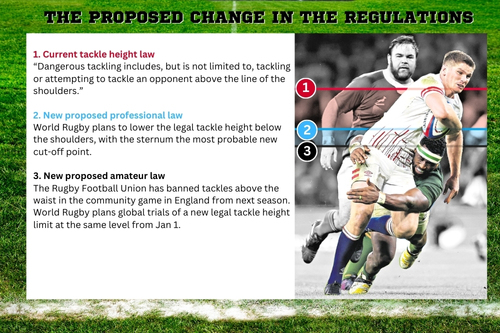The chief executive of World Rugby, Alan Gilpin, confirmed on Thursday in an interview with the Telegraph (UK) that it planned to follow the RFU’s lead in rewriting its own rules on an issue that has left the sport bitterly divided.
Gilpin also said the “likelihood” was that the legal tackle height in the international and professional club game, which currently lies at shoulder level, would not be lowered as far as the waist.
Unlike the RFU law change, which takes effect from next season, changes to the legal tackle height at the top end of the sport would not be any earlier than the 2024-25 season and may not even be in place until after the 2027 World Cup.
 “We need to get players tackling lower at every part of the game. Obviously, there’s an elite part of the game where we’re doing a huge amount of work and we’ve used sanctions, and red cards in particular, trying to drive changes in behaviour. It requires significant buy-in from the game in different parts of the world.
“We need to get players tackling lower at every part of the game. Obviously, there’s an elite part of the game where we’re doing a huge amount of work and we’ve used sanctions, and red cards in particular, trying to drive changes in behaviour. It requires significant buy-in from the game in different parts of the world.
“You’ll always have the traditionalists, I guess, who understandably say, ‘Stop tweaking things and don’t change too much, because we’re really concerned about losing the inherent fabric of the sport’ – and we all absolutely get that.
“At the same time, we’ve got to make sure that we are attracting people to the sport that is safe to play – or is as safe to play as a sport that’s a contact one can be.
What will the consequences be?
What will the ripple effects be of such a drastic change on the sport as a spectacle? Both intended and unintended consequences must be considered.
Firstly, the clear aspects. Lanky-limbed off-loaders are sure to become more valuable. While he made a significant impact on the sport as a back-to-back World Cup-winner, ex-All Blacks centre Sonny Bill Williams will curse that he retired too early. Imagine how much havoc could be caused by an in-form Leone Nakarawa, the supremely dextrous Fiji lock, if defenders are not permitted above his sternum.
Upright wrap-tackles, often featuring multiple defenders and widely known as “choke tackles”, grew in popularity as a means of smothering attacks and stopping opponents from freeing passes out of contact. It may still be possible to slow down opposition phase-play, and perhaps force a turnover by creating a maul, but surely much more challenging. Pick-and-go sequences, regarded by many as a blight on the game, could grow in influence. How does one stop them without standing tall?
Defenders arriving second to the contact area will often hold up a carrier under current laws. Will they now wait for the ball to hit the floor and flood into the ruck even more ferociously in hunched-over jackal positions? The worry is that the breakdown is already a mine-field for injuries and governed by eccentric refereeing interpretations. This is unlikely to alter either of those things. Quite the opposite.
Rugby union should always reward powerful runners, muscular scrummagers and athletic jumpers, but it will be interesting to monitor any gradual changes in body composition among elite teams and across positions.
What are your thoughts? How with this affect the sport?





